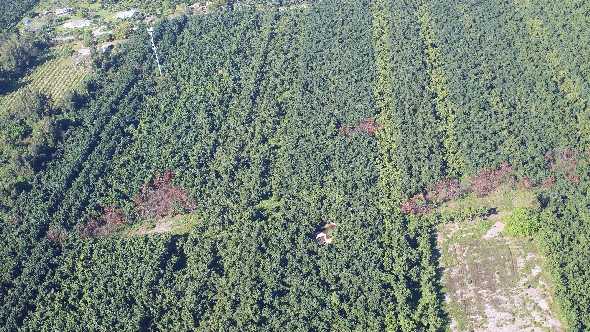Eyes In The Sky Provide Early Detection Of Destructive Avocado Disease
According to University of Florida researchers, low-altitude aerial images can detect laurel wilt, a devastating avocado disease. This scientific breakthrough could give growers an early way to identify diseased trees and perhaps help reduce losses to the $100 million-a-year economic impact avocados provide Florida.
Reza Ehsani, an associate professor in agricultural and biological engineering at the UF/IFAS Citrus Research and Education Center in Lake Alfred, used a multispectral camera that distinguishes between laurel wilt-affected trees and healthy ones.

A view from a low-altitude helicopter shows avocado groves in south Miami-Dade County.
Photo courtesy of UF/IFAS
Images taken with the camera from a helicopter have significant implications in the management of this important disease and for the commercial avocado industry in Florida. Ehsani said he expects the Federal Aviation Administration to open U.S. airspace for commercial use of unmanned aerial vehicles (which could be equipped with such cameras) by 2017.
“Ultimately, we think that small UAVs, equipped with the right multiband camera, can be used for scouting for this disease, which could potentially be very cost-effective,” Ehsani said. “The results of this study will enable growers or service companies that use UAVs to detect this disease at an early stage.”
Until now, aerial detection of laurel wilt was by visual inspection only, which is time-consuming and not always accurate. Follow-up of trees suspect for laurel involved locating the tree in the grove and collecting wood samples for lab analysis. Work conducted by Ehsani could dramatically reduce the time needed to diagnose this disease.
In October 2013, Ehsani and his team flew a helicopter almost 200 feet high over about 150 square miles of commercial avocado groves in southern Miami-Dade County. They used multispectral aerial imagery to find the trees affected by laurel wilt. The study was published April 30 in the online journal PLOS ONE.
The projected avocado harvest for 2014 was 3.9 million tons, although specific figures are not known yet. California produces the most avocados of any state in the U.S., followed by Florida and Hawaii. Ninety-eight percent of Florida’s commercial avocados are grown in Miami-Dade County.









